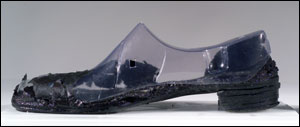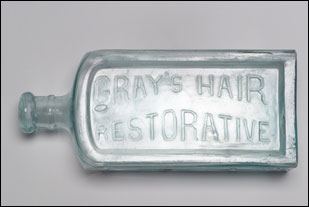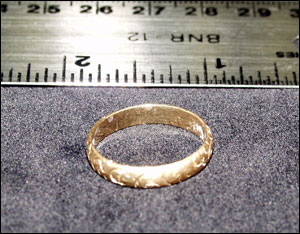Artifacts
Conservation and Preservation | Mariners' Museum | Artifacts
| |  | | |
| | The conserved remnants of one of the crewmen shoes that was recovered from inside of the gun turret. (Courtesy The Mariners’ Museum) | |
Expeditions to the Monitor since the late 1970s have yielded an amazing variety of artifacts that include huge iron components, delicate glass bottles, lumps of coal, wood paneling, a leather book cover, and even walnut halves. In 2001 alone, more than 250 artifacts arrived at The Mariners’ Museum to be conserved and prepared for exhibition at the USS Monitor Center, which opened its doors in 2007.
| |  | | |
| | One of two “Gray’s Hair Restorative” bottles that have been recovered from the wreck. (Courtesy The Mariners’ Museum) | |
The recovery of artifacts from the Monitor has always been done through a scientific approach with oversight by trained professional archaeologists and in accordance with prescribed archaeological standards. Additionally, recovery of artifacts has been closely coordinated with federal and state authorities, so that all major recovery efforts at the site are conducted only after extensive vetting through the archaeological preservation community and members of the public.
| |  | | |
| | Gold ring removed from the hand of the skeletal remains of one of the Monitor sailors that were discovered inside of the gun turret in 2002. (Courtesy The Mariners’ Museum)
| |
Conservation is a painstakingly detailed process that can take years to complete. The Mariners’ Museum conservators are currently working to conserve large iron components recovered from the site including the turret, steam engine, Dahlgren guns, and gun carriages. They are also working on hundreds of small items including a leather boot found during turret excavation, numerous pieces of silverware, the engine room clock, and even buttons from sailors’ uniforms. .
One of the most remarkable artifacts is the red signal lantern, possibly the last thing seen before the USS Monitor sank in 1862, and the first object recovered from the site in 1977. Other artifacts on display include the engine-reversing wheel and register, a ceramic pitcher, the unique four-fluked anchor, the propeller, and a U.S. Navy comb. usn comb Many of these artifacts will be loaned for public display to other museums, such as the Graveyard of the Atlantic Museum in Hatteras, N.C.
| |


 indicates a link leaves the site. Please view our Link Disclaimer | Contact Us | http://monitor.noaa.gov/150th/includes/footer.html
indicates a link leaves the site. Please view our Link Disclaimer | Contact Us | http://monitor.noaa.gov/150th/includes/footer.html